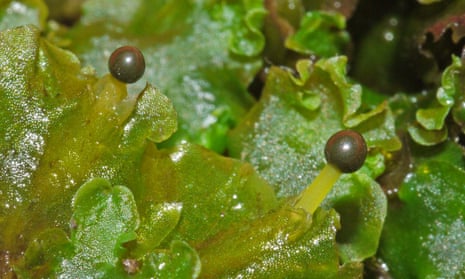Peering down at the emerald lobes of Pellia epiphylla liverwort covering the sides of the ditch, I could see this had recently been the site of intense sexual activity.
On mild, wet days, tiny pockets embedded in the plant’s surface release swarms of swimming male sex cells, each only a few thousandths of a millimetre long. Powered by two lashing flagellae, they gyrate in the surface film of water and swim towards chemical attractants released by egg cells, hidden under a flap of tissue near the tip of the flat green thallus. Most fall by the wayside, exhausted, but a few, perhaps aided by rain splash, reach their destination. The evidence of success – small, round spore capsules resulting from fertilisation – was plain to see.
I scraped a sample from the muddy ditch bank and took it home.
After two days, those green capsules had ripened to spheres of polished jet. By evening, they had begun to rise on glassy stalks and, by morning, they stood a couple of centimetres tall. A day later, they were 7cm, curving towards the light from the window as they lengthened.
What followed, as I watched with a hand lens, was a slow-motion explosion.
The black capsule coat split into four segments, then the contents, a mass of green spores entangled with hair-like elaters, erupted. These specialised cells, with spiral thickenings in their walls and compressed within the intact capsule during its development, act like biological springs when their moment arrives, hurling the spores into the airstream. After five minutes, it was all over: another generation dispatched.
Today’s thalloid liverworts are direct descendants of the first plants that colonised the land surface, with a fossil record extending more than 450m years. They are lowly but their success is unequalled, if you measure on the basis of durability; they have survived five great mass extinctions and still thrive on wet ditch banks everywhere.
I must have watched this annual performance of their spore capsules scores of times but it never fails to stretch the imagination. There was a time when those exploding black capsules on their trembling stalks were the tallest vegetation on the planet.
Phil Gates @seymourdaily

Comments (…)
Sign in or create your Guardian account to join the discussion